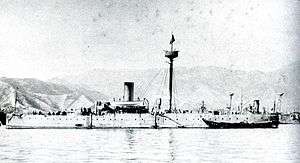Chinese cruiser Jiyuan
 Jiyuan | |
| History | |
|---|---|
| Name: | Jiyuan |
| Builder: | Stettiner AG Vulcan, Stettin, Germany |
| Laid down: | 31 January 1880 |
| Launched: | 2 November 1883 |
| Completed: | 1885 |
| Commissioned: | 11 June 1885 |
| Fate: | Prize of war to Japan, 16 March 1895 |
| Name: | Saien |
| Acquired: | 16 March 1895 |
| Fate: | Mined off Port Arthur, 30 November 1904 |
| General characteristics | |
| Type: | Cruiser |
| Displacement: | 2,440 long tons (2,479 t) |
| Length: | 75 m (246 ft 1 in) w/l |
| Beam: | 10.5 m (34 ft 5 in) |
| Draught: | 4.67 m (15 ft 4 in) |
| Propulsion: |
|
| Speed: | 15 knots (17 mph; 28 km/h) |
| Complement: | 180 |
| Armament: |
|
| Armour: |
|
Jiyuan (simplified Chinese: 济远; traditional Chinese: 濟遠), sometimes transliterated as Chiyuan, was a protected cruiser in the Chinese Beiyang fleet of the Qing government. It was originally ordered as the third vessel in the Dingyuan class of battleships, but as the necessary funds could not be raised and the order was changed to a smaller protected cruiser. The shipbuilder was AG Vulcan Stettin, in Stettin, Germany. Obsolete transliterations of its Chinese name in some western sources include Tche-Yuen, and Tsi-yuan.
The ship was captured by the Japanese during the first Sino-Japanese War, and was commissioned into the Imperial Japanese Navy as the second class cruiser Saien (済遠 巡洋艦 Saien jun'yōkan) on 16 March 1895. Obsolete transliterations of its Japanese name include Saiyen.
Design
Jiyuan is said to be the first protected cruiser built by Germany. From its completion, there were many critics about its performance. Some sources claim that it was modeled after the British HMS Hotspur, but this claim has never been verified.
Sir Robert Hart, promoter on behalf of the British shipbuilding industry, strongly lobbied senior Qing officials for its purchase, and the Chinese purchaser Li Fengbao (李鳳苞), who at the time was the Chinese Envoy to Germany, had to resign before the ship was finally completed.
Career
China
Originally scheduled to be delivered 1884, due to the Sino-French War completion was postponed to 1885. Jiyuan took part in the Battle of Pungdo and Battle of the Yalu River (1894) in the First Sino-Japanese War. Without achieving any military success, it ran down another Chinese cruiser, Yangwei, during the battle. Later, it was captured by the Imperial Japanese Army after the Battle of Weihaiwei as a prize of war. The Imperial Japanese Navy later commissioned it into Japanese service (keeping the same Chinese character name, 濟遠) as Saien.
Japan
The service record of Saien in the Imperial Japanese Navy was short. It was among the warships that supported the Japanese invasion of Taiwan, and took part in the bombardment of the coastal defences of Takow (Kaohsiung) on 13 October 1895. Saien was re-classified as a third-class coastal defense vessel on 11 November 1904, but was assigned to duties as part of the blockading force at the Battle of Port Arthur in the opening stages of the Russo-Japanese War of 1904-1905. It sank after being mined off of Port Arthur (38°51′N 121°05′E / 38.850°N 121.083°E) on 30 November 1904.
References
- Dull, Paul S. (1978) A Battle History of the Imperial Japanese Navy ISBN 0-85059-295-X
- Evans, David. Kaigun: Strategy, Tactics, and Technology in the Imperial Japanese Navy, 1887-1941. US Naval Institute Press (1979). ISBN 0-87021-192-7
- Gardiner, Robert (editor) (2001) Steam, Steel and Shellfire, The Steam Warship 1815-1905, ISBN 0-7858-1413-2
- Howarth, Stephen. The Fighting Ships of the Rising Sun: The Drama of the Imperial Japanese Navy, 1895-1945. Atheneum; (1983) ISBN 0-689-11402-8
- Jane, Fred T. The Imperial Japanese Navy. Thacker, Spink & Co (1904) ASIN: B00085LCZ4
- Jentsura, Hansgeorg. Warships of the Imperial Japanese Navy, 1869-1945. Naval Institute Press (1976). ISBN 0-87021-893-X
- Schencking, J. Charles. Making Waves: Politics, Propaganda, And The Emergence Of The Imperial Japanese Navy, 1868-1922. Stanford University Press (2005). ISBN 0-8047-4977-9
External links
- Jiyuan in Baidu Baike (Chinese)
- 备受争议的大清海军“济远”舰 (Chinese)
Coordinates: 38°51′N 121°05′E / 38.850°N 121.083°E